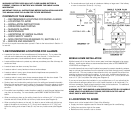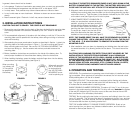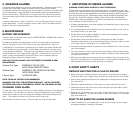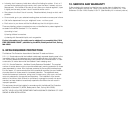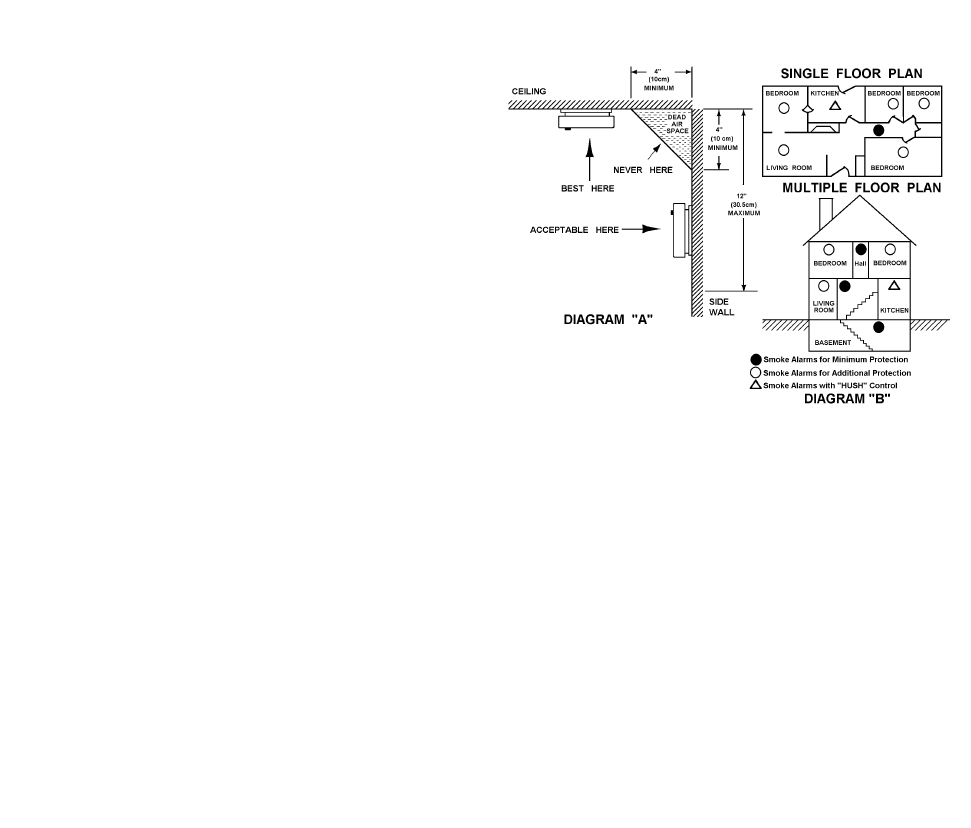
WARNING! BATTERY DOOR WILL NOT CLOSE UNLESS BATTERY IS
PRESENT. REMOVAL OF BATTERY WILL RENDER THE SMOKE ALARM
INOPERATIVE.
IMPORTANT! READ ALL INSTRUCTIONS BEFORE INSTALLATION AND KEEP
THIS MANUAL NEAR THE ALARM FOR FUTURE REFERENCE.
CONTENTS OF THIS MANUAL
1 -- RECOMMENDED LOCATIONS FOR SMOKE ALARMS
2 -- LOCATIONS TO AVOID
3 -- INSTALLATION INSTRUCTIONS
4 -- OPERATION AND TESTING
5 -- NUISANCE ALARMS
6 -- MAINTENANCE
7 -- LIMITATIONS OF SMOKE ALARMS
8 -- GOOD SAFETY HABITS
9 -- NFPA PROTECTION STANDARD 72, SECTION 2-2.1
10 -- SERVICE AND WARRANTY
Do not try to repair the smoke alarm yourself. Refer to the instructions in Section 11
for service.
1.RECOMMENDED LOCATIONS FOR ALARMS
• Locate the first alarm in the immediate area of the bedrooms. Try to protect the
exit path as the bedrooms are usually farthest from the exit. If more than one
sleeping area exists, locate additional alarms in each sleeping area.
• Locate additional alarms to protect any stairway as stairways act like chimneys for
smoke and heat.
• Locate at least one alarm on every floor level.
• Locate an alarm in every bedroom where a smoker sleeps.
• Locate an alarm in every room where electrical appliances are operated (i.e.
portable heaters or humidifiers).
• Locate an alarm in every room where someone sleeps with the door closed. The
closed door may prevent the alarm from waking the sleeper.
•Smoke, heat, and combustion products rise to the ceiling and spread horizontally.
Mounting the smoke alarm on the ceiling in the center of the room places it closest
to all points in the room. Ceiling mounting is preferred in ordinary residential con-
struction.
• For mobile home installation, select locations carefully to avoid thermal barriers that
may form at the ceiling. For more details, see MOBILE HOME INSTALLATION
below.
•When mounting an alarm on the ceiling, locate it at a minimum of 4” (10 cm) from
the side wall and 2 feet (60.96 cm) from any inside corner (see Diagram A).
•When mounting the alarm on the wall, it is best to use an inside wall with the top
edge of the alarm at a minimum of 4” (10 cm) and a maximum of 12” (30.5 cm)
below the ceiling, and at least 2 feet (61 cm) from any inside corner (see Diagram
A).
• Put smoke alarms at both ends of a bedroom hallway or large room if the hallway
or room is more than 30 feet (9.1 m) long.
MOBILE HOME INSTALLATION
Mobile homes built in the past five to seven years have been designed to be energy
efficient. Install smoke alarms as recommended above (refer to RECOMMENDED
LOCATIONS and Diagram A).
In mobile homes that are not well insulated compared to present standards, extreme
heat or cold can be transferred from the outside to the inside through poorly insulated
walls and roof. This may create a thermal barrier which can prevent the smoke from
reaching an alarm mounted on the ceiling. In such units, install the smoke alarm on
an inside wall with the top edge of the alarm at a minimum of 4” (10 cm) and a maxi-
mum of 12” (30.5 cm) below the ceiling (see Diagram A).
If you are not sure about the insulation in your mobile home, or if you notice that the
outer walls and ceiling are either hot or cold, install the alarm on an inside wall. For
minimum protection, install at least one alarm close to the bedrooms. For additional
protection, see SINGLE FLOOR PLAN in Diagram B.
WARNING: TEST YOUR SMOKE ALARM OPERATION AFTER R.V. OR MOBILE
HOME VEHICLE HAS BEEN IN STORAGE, BEFORE EACH TRIP AND AT
LEAST ONCE A WEEK DURING USE.
2.LOCATIONS TO AVOID
Alarms must not be located within 3 feet of the following:
• Supply and return registers used for forced air heating and air conditioning.
•Ceiling fans and other high air flow areas.
• Bathrooms which contain a tub or shower.




